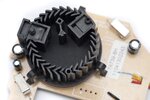electronicsIUST
Member level 3
You probably didn't even understand the operation principle of an optical smoke detector. It's light dispersion, not absorption. Respectively the transmitter and detector should never be placed in front of each other.
But they are not in front of each other! I put transmitter and detector in the chamber like this!

I think its principle of operation is so that when there is no smoke no light reaches from transmitter to the detector and there is no output, but when there is smoke in the chamber, light from transmitter reflects to the detector and it detects presence of smoke.My problem is that when I put transmitter exactly in front of detector (3mm transmitter-detector) it gives no output!!but with 5mm transmitter-detector it works as expected.
- - - Updated - - -


